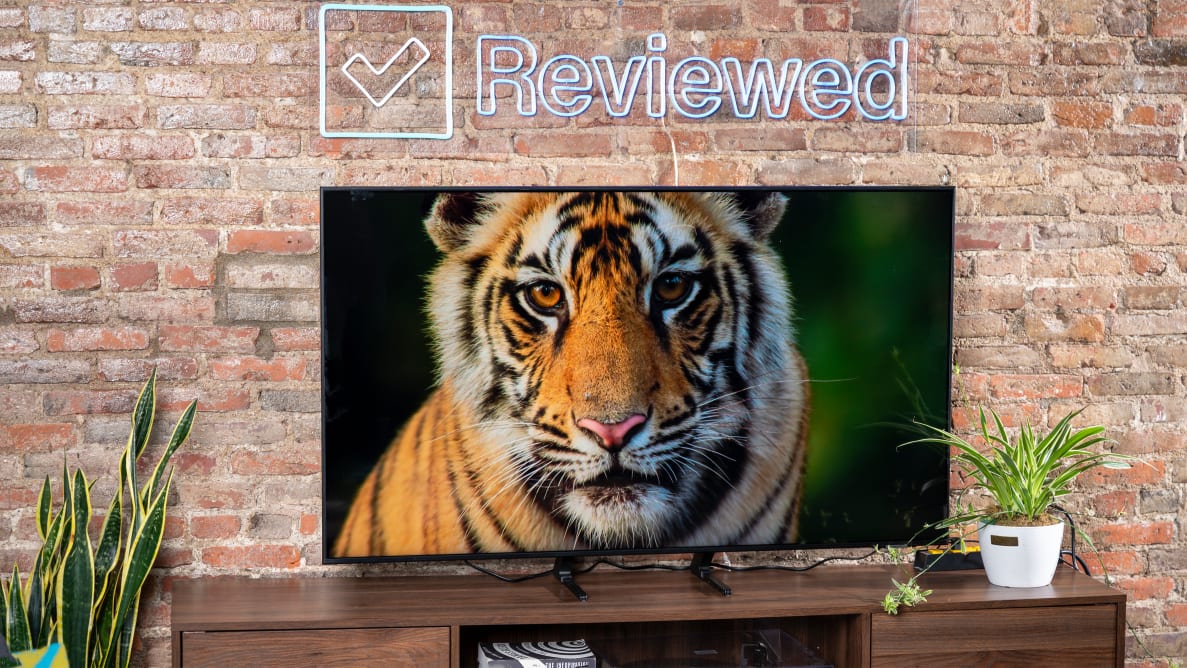Pros
-
Excellent contrast
-
ALLM and VRR
-
Rich color production
Cons
-
No local dimming
-
Limited viewing angles
-
No Dolby Vision
The Q70A offers terrific contrast, rich color, and a dependable toolbox of extra features, particularly if you’re a gamer. Its biggest downside is its lack of full-array local dimming—something most of its competitors do have. Without such hardware, the picture can look washed out and cloudy, especially during dark scenes. It doesn’t support Dolby Vision HDR, either, which might be a sticking point for A/V enthusiasts, but is true of every Samsung TV right now.
The good news is that the Q70A doesn’t feel overpriced for its performance and features, and I suspect that most folks—Samsung fans in particular—will appreciate what it brings to the table. If you don’t consider yourself tied to any one brand, however, you owe it to yourself to explore well-priced alternatives from Vizio, TCL, and Hisense.
About the Samsung Q70A
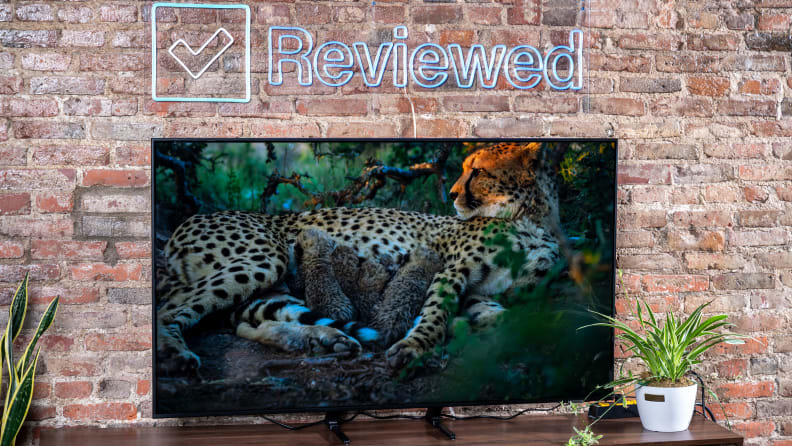
The Q70A is available in four sizes, all of which are currently seeing steep discounts across the board.
The Samsung Q70A is available in four sizes ranging from 55 inches to 85 inches. Our review unit is a 55-inch model that we purchased ourselves. Prices of this TV have come down in recent months, and the prices listed below were accurate at the time of publishing.
Here’s how the models compare:
- 55-inch (Samsung QN55Q70AAFXZA), MSRP $849.99
- 65-inch (Samsung QN65Q70AAFXZA), MSRP $999.99
- 75-inch (Samsung QN75Q70AAFXZA), MSRP $1,499.99
- 85-inch (Samsung QN85Q70AAFXZA), MSRP $1,999.99
All four of these models feature the same hardware and software features, so we don’t expect there to be any major differences between sizes.
Here’s a rundown of the key specs shared by every size in the series:
- Resolution: 4K (3,840 x 2,160)
- Display type: Edge-lit LED with quantum-dot color
- HDR support: HDR10, HDR10+, HLG
- Dolby Atmos: Passthrough via HDMI ARC/eARC (no onboard decoding)
- eARC support: Yes (HDMI 3)
- Native refresh rate: 120Hz
- Smart platform: Tizen Smart TV
- Color: DCI-P3 color space/10-bit chroma resolution
- Variable Refresh Rate (VRR): Yes
- Auto Low Latency Mode (ALLM): Yes
- Other features: FreeSync, Google Assistant, Amazon Alexa, Bixby, Samsung Health, Q-Symphony
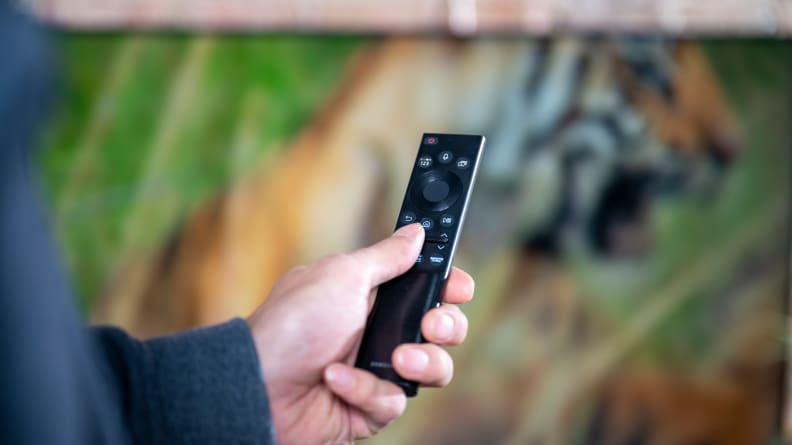
Samsung's new Solar Cell remote control charges automatically using solar power. You can also charge it via a USB-C cable.
The Q70A ships with Samsung’s new Solar Cell remote control, which is powered by a lithium-ion battery that recharges itself via sunlight or USB-C for those times you need a charge in a hurry. At any given time, users can check on their remote’s battery status in the TV’s settings menu. The Solar Cell remote is also equipped with a microphone for various voice commands.
The TV's design is quite fetching; its super-slim panel is held up by two feet fixed to the center section of the display. While we opted to keep it detached during testing, there's an included square-shaped slab that snaps onto the feet in order to hide their appearance. The result is a short, elegant-looking pedestal that serves as a platform for a soundbar.
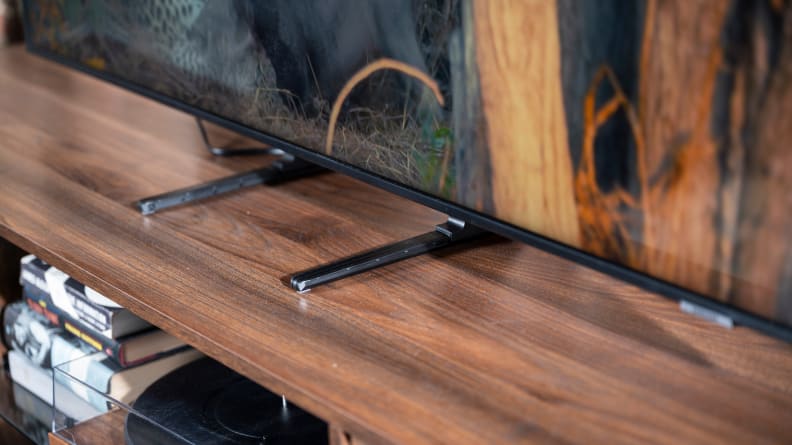
For testing, we opted to remove the square-shaped piece that snaps onto the top of the stand's feet (not seen here). When it's attached, the apparatus takes the form of a single, square-shaped pedestal.
Performance data
Before testing each TV, we make sure the panel is on and receiving a continuous signal for at least 24 hours, allowing the pixels plenty of time to warm up. Our 55-inch Q70A received this standard warm-up time before any readings were taken. In addition, the TV received the latest firmware updates at the time of testing.
For both SDR and HDR tests, we used Samsung’s “Movie” picture mode. We’ve chosen this setting because of its accuracy, but performance may vary depending on which picture mode is enabled. For example, you’re likely to experience a brighter picture with different settings enabled, but it may interfere with color temperature and overall color accuracy.
To get a sense for the TV’s average performance, we use a standard ANSI checkerboard pattern for most of our basic contrast tests. We also use white and black windows ranging from 2% to 90% to test how well the contrast holds up while displaying varying degrees of brightness.
Our peak brightness measurements are taken with sustained windows to represent the TV’s peak brightness over a sustained period of time. Specular highlights (like brief flashes of reflected light) might reach higher brightness levels, but not for sustained periods of time.
All of our tests are created with a Murideo Seven 8K signal generator and tabulated via Portrait Displays’ Calman Ultimate color calibration software. I'll expand on our test results throughout the review, but for now, here are some key takeaways:
• HDR contrast (brightness/black level): 572.9 nits/0.063 nits (ANSI checkerboard) • SDR contrast (brightness/black level): 292.5 nits/0.031 nits (ANSI checkerboard) • HDR peak brightness (sustained): 575.4 nits (40% white window) • HDR color gamut coverage (DCI-P3/10-bit): 86% • SDR color gamut coverage (Rec.709): 99%
These tests were carried out with the Q70A’s “Picture Clarity” settings (“Judder Reduction,” “LED Clear Motion,” and “Noise Reduction”) disabled. In addition, its gamma was set to 2.2 for SDR tests, “Contrast Enhancer” was disabled, and the “Color Tone” selector was set to “Warm2.”
Connectivity
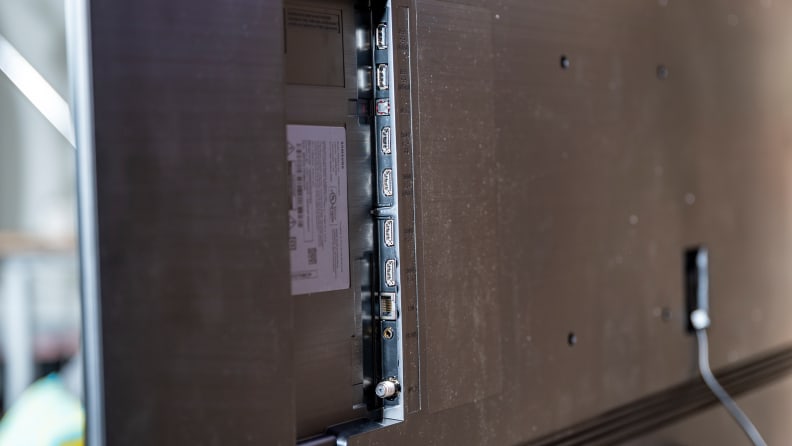
Only one of the Q70A's HDMI ports (HDMI 4) is equipped for 4K gaming at 120fps.
The Q70A offers a better-than-average array of connectivity options, including one HDMI 2.1 port for 4K gaming at 120fps.
Here’s what you’ll find in a cutout on the back of the panel:
- 3x HDMI 2.0 (1x eARC)
- 1x HDMI 2.1 (HDMI 4)
- 2x USB 2.0
- RF connection (cable/antenna)
- Ethernet (LAN) input
- Digital audio output (optical)
What we like
Deep, inky black levels and ample brightness
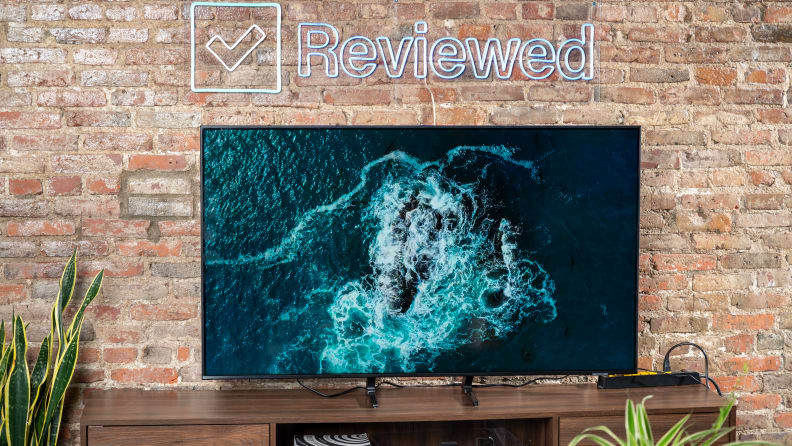
Consistently deep black levels, combined with above-average brightness, makes for a picture that pops—especially during HDR content.
When it comes to picture quality, contrast is critical. Ideally, a TV should not only get bright enough to showcase highlights, but dark enough to reveal shadow detail. The Q70A does just that, pairing terrific (and consistent) black levels with better-than-average brightness. The result is commendable contrast across all types of content, which goes a long way toward elevating the overall picture.
Let’s start with brightness. During SDR content (think cable TV, most streaming shows, and over-the-air broadcasts), the Q70A settles into around 300 nits of brightness. This is more than enough luminance for regular video.
When it comes to newer content mastered for High Dynamic Range (HDR), the Q70A tops out between 550 and 600 nits. While this pales in comparison to a high-end LED TV like Samsung’s own QN90A Neo QLED, which is capable of outputting 1,500 nits during HDR, it’s enough horsepower to make an appreciable difference for content of this type. Not everything is mastered for HDR, but high-profile streaming shows, newer Blu-ray releases, and plenty of video games support the format.
Our lab tests indicate that the Q70A consistently outputs black levels in the 0.03- to 0.07-nit range, with the higher end of that range being what you can expect during brighter HDR content. These results are very good for a standard LED TV with an edge-lit display, and aside from some panel issues (which I’ll get into shortly), the Q70A’s contrast is easily the most impressive aspect of its performance. The ability for the Q70A to get dark—together with its above-average brightness—makes for a picture that pops with plenty of detail, even when you’re not watching HDR content.
It comes with a host of features—especially for gamers
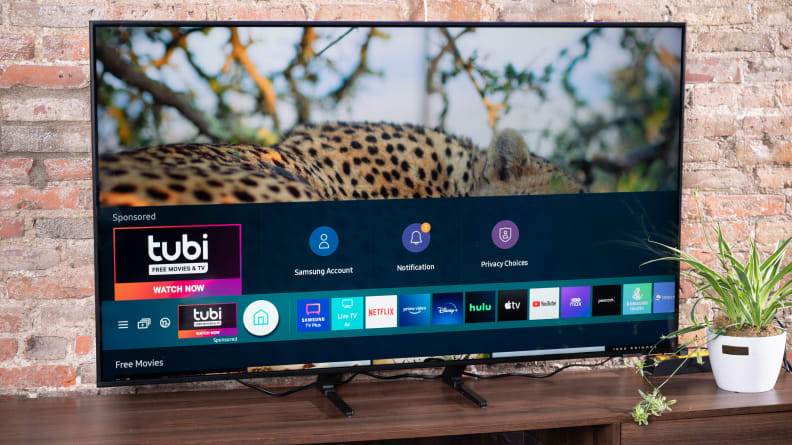
Samsung's built-in smart platform, Smart Hub, is in tow, as well as ALLM and VRR for next-generation gaming.
As an upper-mid-range TV, one expects the Q70A to offer its fair share of extras, and it does not disappoint. This TV might not be as kitted out as a high-end Samsung flagship, but there are enough features here to put it in line with what we expect from a TV in this price range—especially if you’re a gamer.
The Q70A supports both Auto Low Latency Mode (ALLM) and Variable Refresh Rate (VRR)—two relatively new, game-changing features (literally). ALLM optimizes the TV’s settings whenever a console is detected, and VRR keeps gameplay smooth by synchronizing the frames on screen with whatever console is running. If you own (or plan on owning) a PlayStation 5 or Xbox Series X, the Q70A is one of the better suitors in its price range.
When you pair the Q70A’s gaming enhancements with its 120Hz native refresh rate, its upside as a gaming TV really comes into focus. While 4K gaming at 120fps is limited to only one of the TV’s four HDMI ports, if you’re shopping in this price bracket and don’t want to plunk down more money for a higher-end TV, this is a great feature to have in your back pocket.
And while we’re on the subject of native refresh rate, it’s worth noting that the Q70A’s motion handling is quite good. There was very little to nitpick during my usual motion tests, and I didn’t flag much judder while watching actual content. In addition, Samsung’s top-notch motion enhancement suite offers a wide range of customization options if you want to tweak the look and feel of the motion handling on an input-by-input basis.
The Q70A comes with the newest iteration of Samsung’s Tizen-based Smart Hub software, which is one of the better smart platforms the industry has to offer at the moment. There are plenty of customization options available, a wide range of app support, and once you get used to the interface, navigation is pretty easy. It’s not our favorite smart platform going, but it certainly gets the job done, and is generally snappy and easy to use. Finally, when you sign on for a Samsung TV, you're getting a handful of nifty extras that some folks might appreciate: Samsung Health, a selection of fitness programs that link with other Samsung products, and Multi View, which allows you to view multiple sources at the same time.
Quantum-dot color looks good—with one caveat
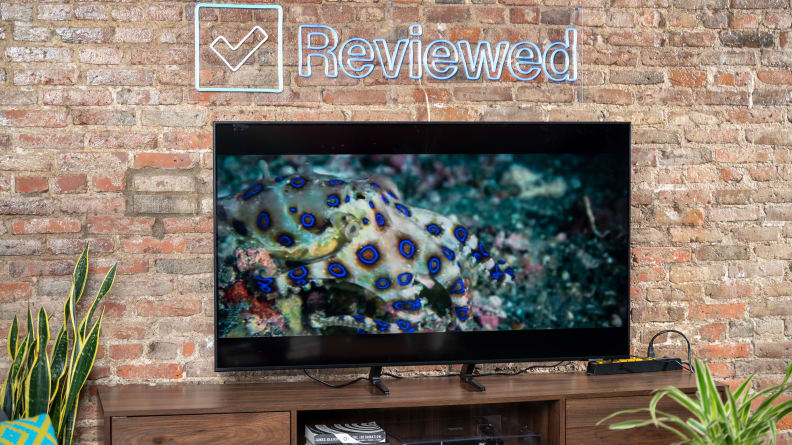
The Samsung Q70A blends its excellent contrast with reliably rich color in both SDR and HDR. The TV tends to push magenta-adjacent hues towards a redder shade, but most people probably won’t notice. For the most part, you can expect color production that’s roughly on-par with both the step-up Q80A and the step-down Q60A.
According to our lab tests, the Q70A covers about 86% of the extra-wide HDR color space (DCI-P3), which is fairly middling for a TV in this price range. Fortunately, Samsung’s picture processing makes the most out of HDR color—for all the HDR content I watched, it rarely looked as though I was missing out on a more colorful experience. That said, eagle-eyed viewers and bonafide color chasers might be better off spending a bit more on something like the Hisense U7G or the Vizio P-Series Quantum, both of which offer better color production, in part because of their higher brightness levels.
What we don’t like
A lack of local dimming can spell trouble
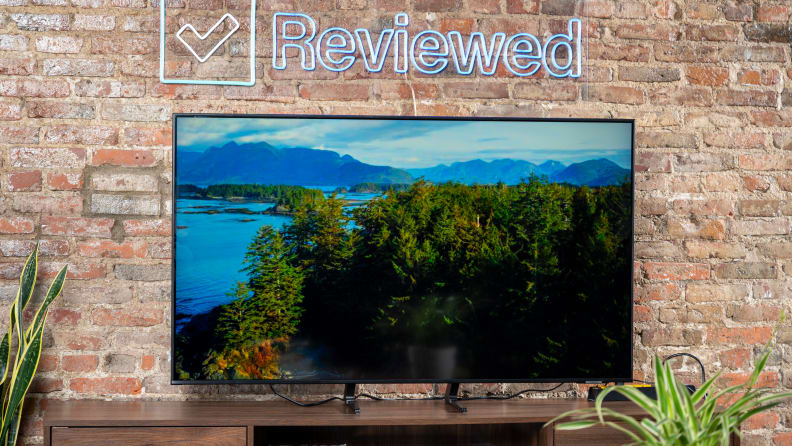
Without local dimming, the Q70A struggles to gracefully distribute its luminance.
The Q70A’s biggest performance issue has to do with its display technology. It isn’t equipped with full-array local dimming, so unlike a TV with such hardware, light generated by the panel can’t be allotted and controlled across several zones sitting behind the picture. In other words, instead of several zones of adjustable LEDs carefully tweaking the contrast in real-time, the Q70A is stuck with a less versatile source of illumination and some meager software dimming.
If this is all still confusing, allow me to put it in simpler terms: The Q70A struggles to keep the dark parts of the picture adequately dark while brighter picture elements are in play. Dark regions of the screen are regularly inflicted with collateral brightness—particularly during HDR content, when the TV is trying to pump up the highlights.
These weaknesses are especially visible during opening title sequences, end credits, and nighttime sequences. So a starfield backdrop during a sci-fi show might appear lumpy, uneven, and bulging with a blue-tinted glow—especially in a dark room.
It’s very possible that this effect is more severe on the unit we purchased than on other sets—panel discrepancy is a real phenomenon, and there will always be slight differences between one TV’s panel and another of the same model. Still, none of the models in the Q70A series feature full-array local dimming, so I don’t expect this issue to be completely absent from every unit.
Limited viewing angles
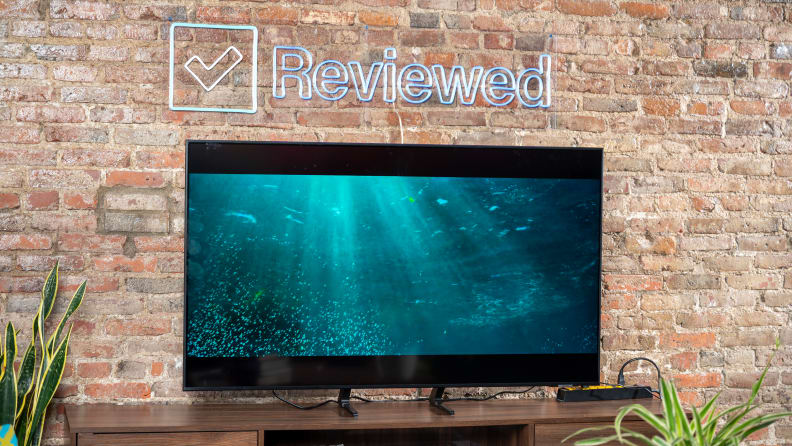
While not demonstrated in the image above, if you view the Q70A away from a direct, head-on angle, the picture quality begins to deteriorate. Such is the case with most VA-style panels.
Every size in the Q70A lineup is built using VA-style panels, which tend to offer terrific contrast at the expense of wide viewing angles. Such is the case for the Q70A, whose impressive contrast comes with a cost: If you view this TV at off-angles, its picture will look fuzzy and washed-out.
It doesn’t take much of an off-angle to knock the picture out of whack, either—during testing, I only had to move my chair off to the side by about three to four feet before the picture began to deteriorate.
The good news is that I didn’t notice much (if any) color-shifting during off-angle viewing, and most of the picture deterioration could be described as a sudden drop in contrast; reds do not drift into an orangey hue as I’ve seen happen with VA panels in the past.
Still, if you’re shopping for 65-, 75-, or 85-inch TV to be the star of the show for group viewings with friends and family, you might be better off exploring TVs with IPS-style panels (unless you want to spring for an OLED panel, of course). The Samsung Q80A—a step up from the Q70A in both price and performance—uses a variant of an IPS-style panel, and its viewing angles are much more accommodating than the Q70A’s. You’ll lose the deep, inky black levels of the Q70A, but the Q80A’s added brightness goes a long way in off-setting its shallow black levels.
No Dolby Vision support
Dolby Vision, a proprietary version of HDR, is considered by many to be the gold standard due to its stricter criteria when compared to the open-source HDR10 format. Essentially, Dolby maintains a higher standard for its HDR stamp of approval, and many folks (myself included) feel that Dolby Vision is the best version of HDR you can currently experience as a result of this higher bar for entry.
Unfortunately, there are no Samsung TVs that support Dolby Vision just yet, and that includes the Q70A. For many people, this won’t be a problem. After all, the Q70A does support HDR10+, which comes close to capturing the same sort of magic. That said, if you’re hoping to experience Dolby Vision—be it by way of streaming or gaming—you’ll have to invest in a Dolby Vision TV, and right now, that means buying something other than a Samsung TV.
Should you buy it?
Maybe, but it’s worth exploring alternatives first
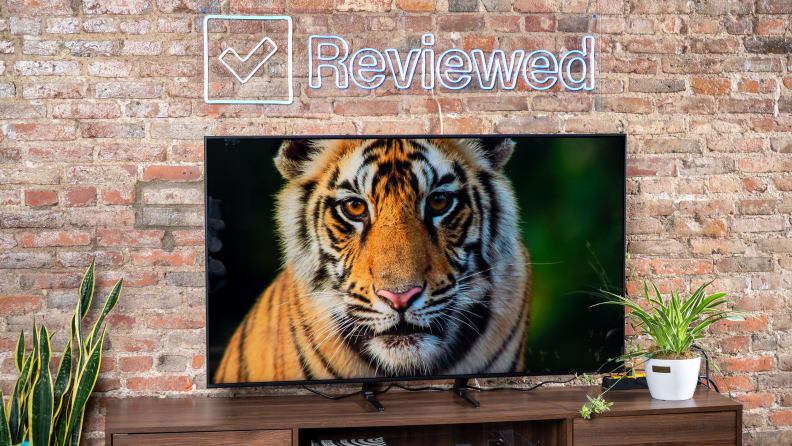
The Q70A feels appropriately priced (especially now that these models are seeing price drops), but it's worth looking into non-Samsung alternatives.
If you want a new Samsung TV and you don’t want to go all-in on the company’s flagship model, the Q70A is a decent compromise. It offers more upside than the Q60A but isn’t quite as impressive as the Q80A, namely when it comes to brightness. The best thing I can say about the Q70A is that it feels appropriately priced, especially now that prices for these models are coming down.
I would invite you, however, to step outside the Samsung lineup for a moment and consider some of the alternatives. The Hisense U7G and the Vizio P-Series Quantum cost a bit more and don’t offer as many size options, but their color production is better, they get much brighter than the Q70A, and both models feature a comparable set of gaming enhancements. Last year’s TCL 6-Series is yet another fantastic alternative that can be had for roughly the same price, and that TV has the added bonus of built-in Roku software.
The Samsung Q70A does precisely what it needs to do given its place in the Samsung lineup, and other than its lack of local dimming, most of its pain points won’t hurt too much—especially if you’re upgrading from an older, lesser TV. Still, it’s worth your time to explore the competition. There are quite a few value-forward options in this price range.
Meet the tester
Michael Desjardin graduated from Emerson College after having studied media production and screenwriting. He specializes in tech for Reviewed, but also loves film criticism, weird ambient music, cooking, and food in general.
Checking our work.
Our team is here to help you buy the best stuff and love what you own. Our writers, editors, and experts obsess over the products we cover to make sure you're confident and satisfied. Have a different opinion about something we recommend? Email us and we'll compare notes.
Shoot us an email